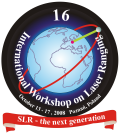LIST OF ABSTRACTS
Session 13: "Targets, Signatures and Biases"
Signal Strength Measurements and Retroreflector Array Design
David Arnold
SAO, USA,
E-mail: david-arnold@earthlink.net
Very high cross section is requried for retroreflector arrays on high altitude satellites. Uncoated solid cubes and hollow retroreflectors are being considered for future satellites. It would be helpful to measure the in-orbit cross section of existing high altitude arrays. Measuring the energy received at the satellite using the sensors on the T2L2 satellite would be helpful in understanding discrepancies between measured and calculated signal strength.
Laser Retro-reflector Arrays on the Compass Satellites
Chen Wanzhen, Yang Fumin, Wang Yuanming, Li Pu
Shanghai Astronomical Observatory, Chinese Academy of Sciences, China
E-mail: cwz@shao.ac.cn
"COMPASS" is the regional satellite navigation system in China, and the constellation will consist of 12 satellites, of which 5 GEO, 3 IGSO and 4 MEO. The effective reflective areas of LRAs for these satellites are 770cm2 for GEO and IGSO, 360cm2 for MEO respectively. The diameter of the corner cubes is 33mm. All corner cubes are without coating both on front face and back faces. The paper presents the characteristics of the Laser Retro-reflector Arrays of "COMPASS".
SLR Coverage Analysis for STSAT-2
Kyunghee Kim*, Sang-Hyun Lee*, Jun Ho Lee**, Jonghan Jin***,Noh Hoon Myung*
* SaTReC, KAIST, Republic of Korea
** Department of optical engineering, Kongju National University
*** BUPE Group, KAIST
E-mail:khkim@satrec.kaist.ac.kr
Poster:
STSAT-2 (Science and Technology of Satellite - 2) is a low earth orbit micro satellite for the satellite technology research and space
science. This satellite is the first Korean satellite which will be launched by the KSLV-1 (Korea Space Launch Vehicle - 1) in 2009 in
Korea. It has three missions: the DREAM mission, the SLR mission and the space core technology verification. Among other things, the
SLR mission is to measure the precise distance between the STSAT-2 and a SLR ground station and then to determine the precise orbit of
it. In this paper, as one of the SLR mission analysis, the SLR coverage is analyzed during the SLR mission according to the attitude
status of the operation concept. Finally, the result is provided.
Effects of Ranging in Circular Polarization
John Luck and Chris Moore
EOS Space Systems Pty.Limited, Canberra, Australia
Email: john-luck@bigpond.com
As reported at the 2007 Grasse Technical Workshop, Stromlo SLR can alternate between linear and circular polarization transmitted beams by the insertion and removal of a quarter-wave plate (QWP). Control of insertion and removal allows coincidence with Normal Point bin boundaries. This paper presents an analysis of data obtained using ETS-8 during a very clear (and rare) night in September 2008, in addition to a re-analysis of the 4 Lageos passes described in the Grasse (2007) workshop. By careful use of classical statistics, the results show significant differences between the two polarization states in range measurements and return rates, in the senses predicted by Dave Arnold. Correlations depending upon the angle between the transmitted (linear) polarization vector and the velocity aberration vector are also examined. The targets used are suitable for this experiment because their retroreflectors are uncoated.
Laser Retroreflector Array Development for STSAT-2
Sang-Hyun Lee*, Kyunghee Kim*, Jun Ho Lee**, Jonghan Jin***,Noh Hoon Myung*
* SaTReC, KAIST, Republic of Korea
** Department of optical engineering, Kongju National University
*** BUPE Group, KAIST
E-mail:shlee@satrec.kaist.ac.kr
STSAT-2 (Science and Technology Satellite-2) is a microsatellite to experiment advanced satellite technology and research space science and now has been completed the flight model development. STSAT-2 will be launched by KSLV-1 at Naro space center of Korea in 2009 and injected an eplitical orbit having 300km at the apogee and 1500km at the perigee. It has three missions: As the first mission is to predict total precipitable water using radiometer(DREAM); the second mission is to measure precise distance between STSAT-2 and SLR ground station to precision orbit determination of STSAT-2; the last mission is to verify the bus space core technologies. STSAT-2 was equipped with a laser retroreflector array having hemispherical configuration with one nadir-lookng corner cube in the centre and surrounded by an angled ring of eight corner cubes like ERS-1&2 and Envisat. This paper introduces STSAT-2 and describes the development result of LRA.
Optical Response Simulation for ASTRO-G Laser Reflector Array
Toshimichi Otsubo, Mihoko Kobayashi (Hitotsubashi University), Hiroo Kunimori (NICT), Shinichi Nakamura and Hiroshi Takeuchi (JAXA)
E-mail: t.otsubo@srv.cc.hit-u.ac.jp
Optical response of retroreflectors is being studied for the precise laser range measurement to ASTRO-G, to be launched in 2012. Geometric variation on incidence angle and velocity aberration is modeled assuming the orbit and attitude of this satellite. Due to its highly elliptic orbit unfamiliar to the satellite laser ranging community, the reflector configuration has to be designed with a number of new concepts. Optical response of each retroreflector is precisely simulated as a four-dimensional function, which is to be used for simulating the response from its whole reflector array.











